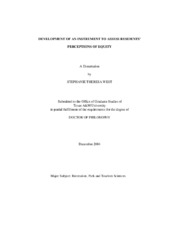| dc.description.abstract | This study examined equity in the context of the allocation of park and recreation resources within a community. The contributions made by this study include: extending the original taxonomy of equity models proposed by Crompton and Wicks (1988); development of a theoretical framework for their original model; providing a current synthesis of equity based literature; advancing the Equity Implementation Model (Wicks & Crompton, 1989) by developing an instrument capable of measuring residents’ perceptions and preferences of park and recreation resource allocation in their community; empirically confirming the legitimacy of alternate dimensions of equity through Structural Equation Modeling; applying information gained from using the instrument to determine the usefulness of selected variables in predicting equity preferences; and comparing data on equity preferences with those of prevailing perceptions to illustrate the utility of the instrument in guiding resource allocation decisions.
Five of the original operationalizations of equity were validated (Compensatory, Taxes Paid, Direct Price, Efficiency and Advocacy). An additional operationalization,
Professional Judgment, was included and also validated, while one of the original dimensions suggested by Crompton and Wicks, Equal Outcomes, could not be distinctively conceptually differentiated and so was discarded. The operationalizations of Equal Inputs and Equal Opportunity could not be differentiated to reflect distinctively different equity concepts. However, further efforts should be invested in operationalizing these two equity concepts, since they do appear to be conceptually different.
Using confirmatory factor analysis, a model consisting of all seven operationalizations (Compensatory, Taxes Paid, Direct Price, Efficiency, Advocacy, Professional Judgment and Equality) was an acceptable fit and all paths were significant at the .05 level, suggesting that the proposed 23-item, seven-dimension scale, P&R-EQUITY, effectively measures seven facets of residents’ perceptions of equity in the allocation of park and recreation resources. Two additional operationalizations (Demonstrated Use and Coproduction Opportunities) emerged during the research which suggested that Demonstrated Interest was inadequately operationalized, so future efforts could be focused on operationalizing those three. The scale developed in this study is intended to help officials make appropriate decisions when allocating park and recreation resources. | en |


